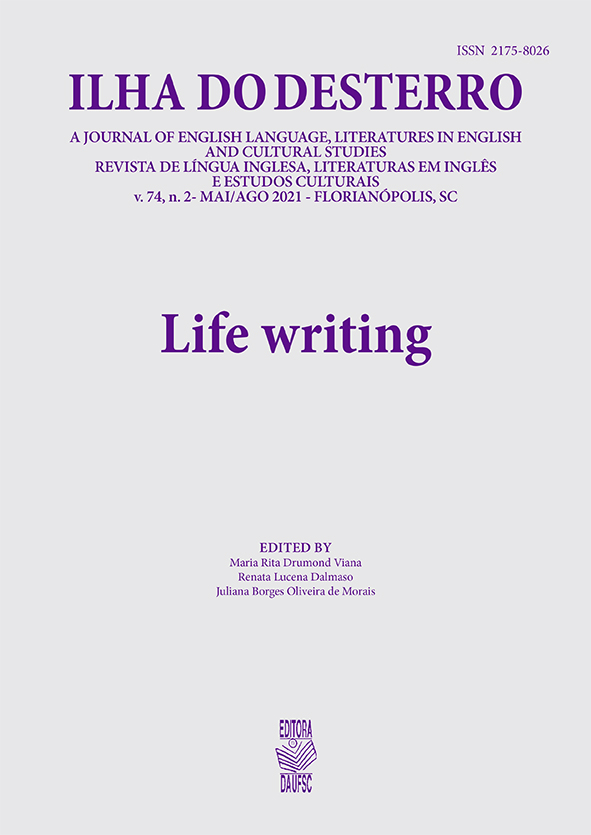A arte da culpa e da Autodivisão: A Spy in the House of Love de Anaïs Nin
DOI:
https://doi.org/10.5007/2175-8026.2021.e78045Resumo
A Spy in the House of Love (1954), romance semiautobiográfico de Anaïs Nin, subjetiviza a experiência física das infidelidades de uma esposa enquanto personifica os terrores mentais de sua culpa por meio de uma figura masculina: The Lie Detector (O Detector de Mentiras). Em uma tournée de autodescoberta, Sabina é uma atriz de bastidores que estetiza seus casos adúlteros em uma sofisticada arte de autodivisão, na qual ela desempenha intermitentemente os papéis de Doña Juana byroniana e da melodramática Emma Bovary para continuar a valorizar sua liberdade sexual com muitos amantes, sem perder a proteção do marido paternal. Embora a culpa seja parte do artifício de Sabina, o risco real inerente às suas autodivisões e autocontradições como resultado de suas infidelidades é se perder em suas próprias mentiras e não conseguir encontrar sua verdadeira identidade além da tela cubista de seus “eus” fragmentados.
Referências
Bair, Deirdre. Anaïs Nin: A Biography. Bloomsbury, 1995.
Balakian, Anna.‘“… and the Pursuit of Happiness’: The Scarlet Letter and A Spy in the
House of Love.” Mosaic: An Interdisciplinary Critical Journal, vol. 11, no. 2, pp. 163-170.
Beauvoir, Simone de. The Second Sex, translated by Constance Borde and Sheila Malovany-Chevallier. Vintage, 2011.
Brians, Paul. “Sexuality and the Opposite Sex: Variations on a Theme by Théophile Gautier and Anaïs Nin.” The Critical Response to Anaïs Nin, edited by Philip K. Jason, Greenwood Press, 1996, pp. 118-132.
Cixous, Hélène. “The Laugh of the Medusa,” translated by Keith Cohen and Paula Cohen. Signs, vol. 1, no. 4, 1976, pp. 875-893.
Franklin V., Benjamin. “Advertisements for Herself: The Anaïs Nin Press.” The Papers of the Bibliographical Society of America, vol. 91, no. 2, 1997, pp. 159-190.
Franklin V., Benjamin, and Duane Schneider. Anaïs Nin: An Introduction. Ohio UP, 1979.
Friedman, Ellen G. “Where are the Missing Contents? (Post)Modernism, Gender, and the Canon.” PMLA, vol. 108, no. 2, 1993, pp. 240-252.
Glicksberg, Charles I. The Sexual Revolution in Modern English Literature. Springer, 1973.
Jarczok, Anita. “Introduction.” A Spy in the House of Love, by Anaïs Nin, Swallow Press, Ohio UP, 2014, pp. vii-xii.
Jensen, Finn. Henry Miller and Modernism: The Years in Paris, 1930-1939. Palgrave Macmillan, 2019.
Knapp, Bettina L. Anaïs Nin. Ungar, 1978.
Nin, Anaïs. A Spy in the House of Love. Swallow Press, Ohio UP, 1995.
Nin, Anaïs. The Diary of Anaïs Nin, volume I: 1931-1934, edited by Gunther Stuhlmann, Harcourt, 1994.
Paiva de Oliveira, Ubiratan. “A Spy in the House of Love: An Introduction to Anaïs Nin.” Ilha do Desterro, vol. 14, 1985, pp. 71-81.
Podnieks, Elizabeth. Daily Modernisms: The Literary Diaries of Virginia Woolf, Antonia White, Elizabeth Smart, and Anaïs Nin. McGill-Queen’s UP, 2000.
Richard-Allerdyce, Diane. Anaïs Nin and the Remaking of the Self: Gender, Modernism, and Narrative Identity. Northern Illinois UP, 1998.
Spencer, Sharon. “Anaïs Nin’s ‘Continuous Novel’ Cities of Interior.” A Casebook on Anaïs Nin, edited by Robert Zaller, The New American Library, 1974, pp. 65-76.
Spencer, Sharon. “The Music of the Womb: Anaïs Nin’s ‘Feminine’ Writing.” Breaking the
Sequence: Women’s Experimental Fiction, edited by Ellen G. Friedman and Miriam Fuchs, Princeton UP, 1989, pp. 161-173. The New Oxford Annotated Bible with the Apocryphal/Deuterocanonical Books, New Revised Standard Version, edited by Michael D. Coogan et al., Oxford UP, 2001.
Tookey, Helen. Anaïs Nin, Fictionality and Femininity: Playing a Thousand Roles. Clarendon Press, 2003.
Woolf, Virginia. “A Room of One’s Own.” A Room of One’s Own and Three Guineas, edited by Morag Shiach, Oxford UP, 2000, pp. 3-149.
Downloads
Publicado
Edição
Seção
Licença
Copyright (c) 2021 Francisco Jose Cortes Vieco

Este trabalho está licenciado sob uma licença Creative Commons Attribution 4.0 International License.
A revista Ilha do Desterro publica artigos e resenhas inéditos, referentes as áreas de Inglês, Literaturas em Língua Inglesa e Estudos Culturais. Publica volumes mistos e/ou temáticos, com artigos e resenhas em inglês e português.
Autores mantém os direitos autorais e concedem à revista o direito de primeira publicação, com o trabalho simultaneamente licenciado sob a Licença Creative Commons Attribution que permite o compartilhamento do trabalho com reconhecimento da autoria e publicação inicial nesta revista.

This work is licensed under a Creative Commons Attribution 4.0 International License.



